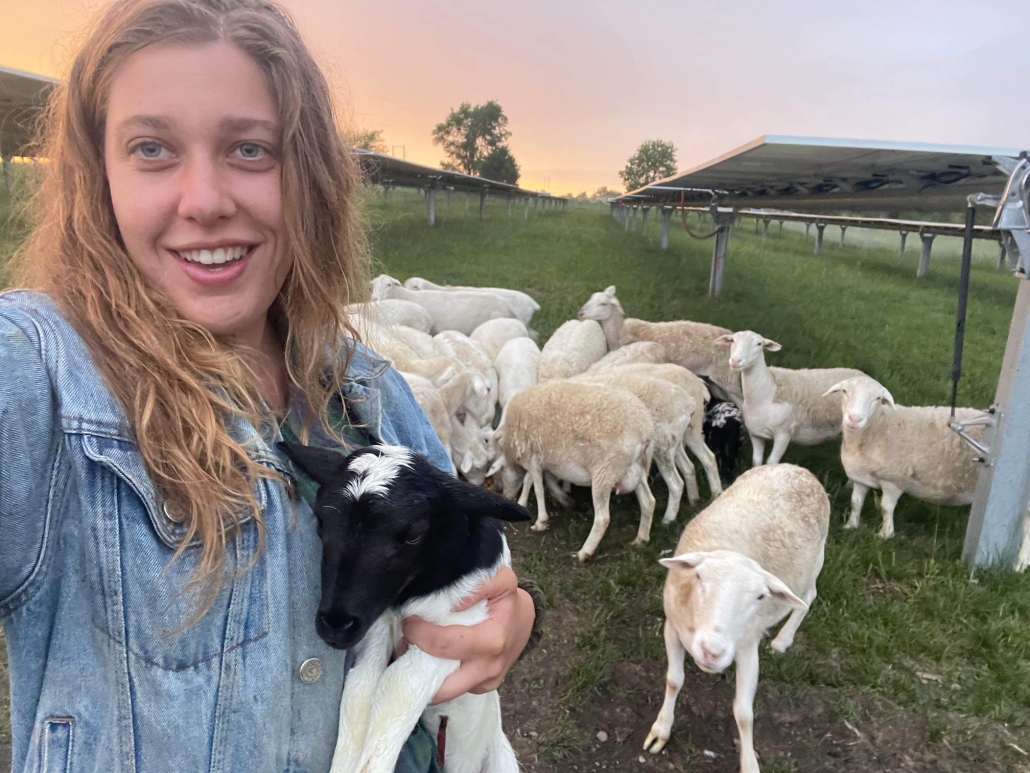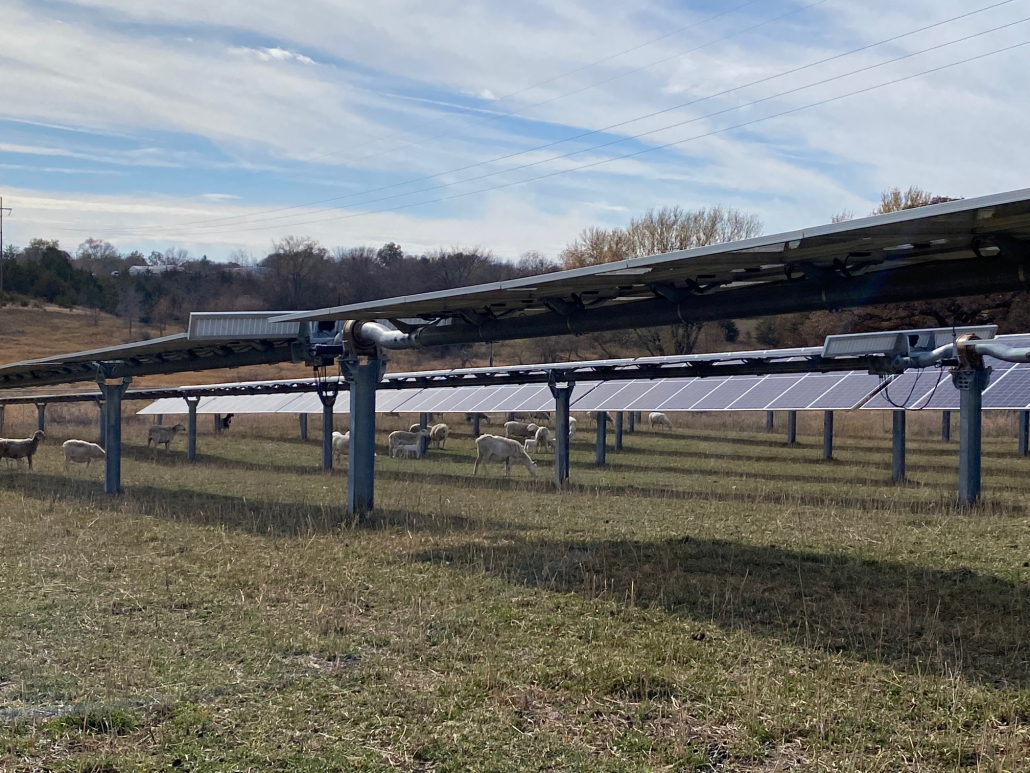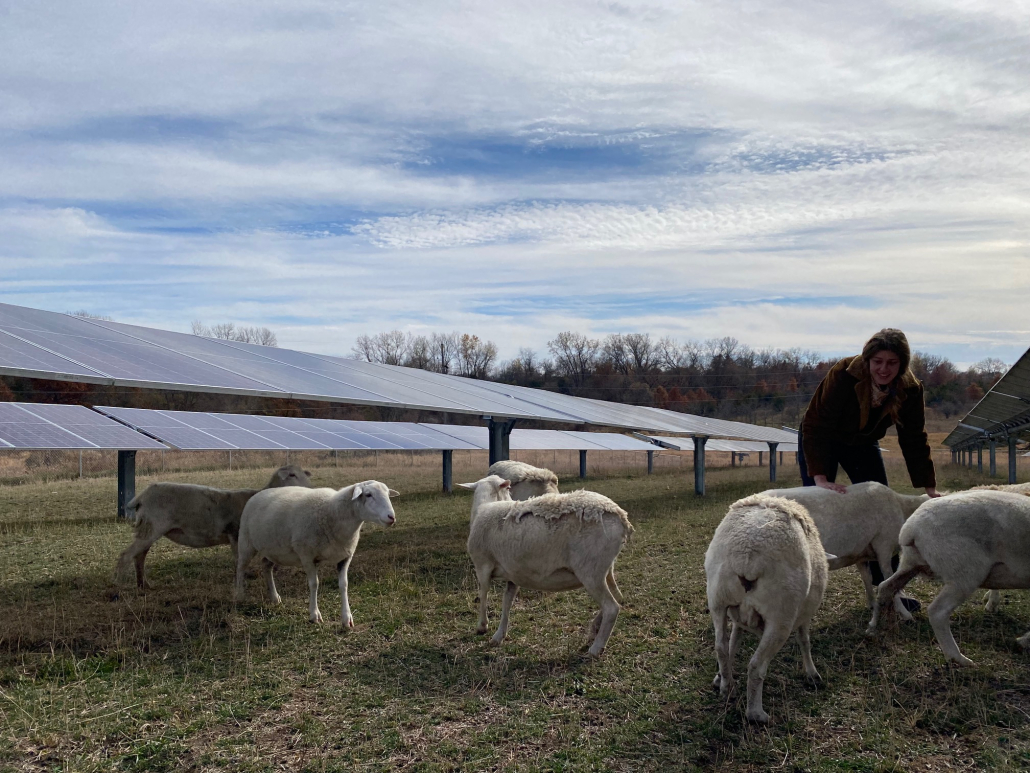The purpose of this paper is to systematically synthesize the potential ecosystem services of agrivoltaics and summarize how these development strategies could address several United Nations Sustainable Development Goals. Led by Agrisolar Clearinghouse partner Leroy Walston, researchers focused on four broad potential ecosystem services of agrivoltaics: (1) energy and economic benefits; (2) agricultural provisioning services of food production and animal husbandry; (3) biodiversity conservation; and (4) regulating ecosystem services such ascarbon sequestration and water and soil conservation.
Tag Archive for: Agrivoltaics
Written By: Alex Delworth, Clean Energy Policy Associate; Center for Rural Affairs
Just off the campus of Maharishi University in Fairfield Iowa, sits a 1.1-megawatt (MW) solar farm. Beneath the panels, a flock of sheep and their newborn lambs are grazing, while beginning rancher Emily Mauntel and her Australian Shepherd Ziggy stand back and admire their work.
Solar farms pose a considerable opportunity for multipurpose agricultural uses in rural spaces. Iowa has seen a rapid increase in solar project development the past two years. According to the Solar Energy Industries Association, the industry is expected to add another 1,304 MW—a 250% increase over current installed capacity—during the next five years. Depending on the type of technology installed, this could mean between 6,520 and 13,040 acres of land will be used for solar production. With proper local siting, these projects will be required to plant and maintain native vegetation underneath the panels. This increase in open pasture presents a unique opportunity to combine traditional land uses with renewable energy development, such as pollinator habitats or open grazing for livestock. An opportunity Emily has already begun benefiting from.
Originally from Michigan, Emily relocated to Fairfield to attend Maharishi International University. While completing a three-month internship at a goat farm in Oregon as part of the university’s Regenerative Organic Agriculture certificate program, her interest in livestock grew. After the internship, she remained in Oregon for another year, working for various livestock operations and gaining experience in the industry. In late 2021, she moved back to Fairfield to work on the university’s vegetable farm and help her peers in their respective livestock businesses.

One day she and a friend were driving past a large solar array in Minnesota and noticed how the infrastructure was perfect for sheep grazing. They knew about the array in Fairfield, which is owned by the university and operated by Ideal Energy, a local solar company. She contacted the solar company to pitch the idea first and gained their approval before approaching the university. Both parties were ecstatic because the university had been looking for somebody to graze livestock and Ideal Energy saw an opportunity to avoid spending about $5,000 for annual landscaping, according to the company. Emily said the two parties came to an agreement that she would graze the array, which provided her an opportunity to access pasture in exchange for landscaping the solar farm. With this agreement, Emily benefited by not having lease payments for the time her sheep were on the farm, saving her approximately $360 per month according to Iowa State University’s land lease estimates, or about $2,520 for 2022.

Once Emily had approval, she and her friend went into business together and purchased a 30-head herd of sheep from an auction in Texas. In May 2022, 29 ewes and one ram were dropped off on the six-acre, 1.1-MW solar farm. Before purchasing the herd, she surveyed the land and determined that, given the amount of growth on the site, she would be able to graze five sheep per acre. That is two more than usual because of how lush the plant life was on the property. The site was planted with a mix of flowering prairie species, including clover, fescue, broad-leaf plantain, and others, which served as a good food source. The sheep were allowed to roam freely throughout the solar array, something Emily said worked well. Overall, she believes rotational grazing would have been more efficient but would have required a larger investment due to the cost of a moveable fence.

What makes this story especially interesting is that the agribusiness model directly addresses two major issues beginning farmers face—access to land and infrastructure. A 2017 survey by the National Young Farmers Coalition found that land access was the number one issue their respondents faced. Young farmers, according to the survey, are also the most inclined to rent, which makes finding land with the right infrastructure more difficult.
The Fairfield solar site’s infrastructure made the land even more attractive to Emily. She said it had sufficient fencing to hold her sheep and keep out predators. Due to the required native vegetation management, it also had plenty of food for the sheep, which means she never had to supplement food for them, except a mineral feed mix for nutrition. A water source to fill up the livestock troughs and an access road straight up to the gate also proved beneficial. Considering all of these factors, Emily was able to cut a lot of costs throughout the process.
Newly energized by the experience she has gained through solar grazers and managing her own livestock, Emily is now looking to return to the West to continue ranching. She and her business partner plan to sell their herd. Emily hopes to see the solar grazing model continue on the site, saying it has been a perfect opportunity for her to gain experience in the industry, and she believes it will be a great opportunity for the next person, as well.
DOE Solar Energy Technologies Office Announces $8 Million in Projects for Agrivoltaics Research
“The U.S. Department of Energy (DOE) Solar Energy Technologies Office announced $8 million in new projects that will research agrivoltaics—agricultural production, such as crop production, livestock grazing, and pollinator habitat underneath solar panels and/or in between rows of solar panels.
The Foundational Agrivoltaic Research for Megawatt Scale (FARMS) funding program will advance agrivoltaics practices and show how it can provide new economic opportunities to farmers, rural communities, and the solar industry. They explore different ways to implement agrivoltaics that will address concerns from the solar industry and farmers. Currently, less than 2% of solar systems utilize agrivoltaic practices.” – Energy.gov
AgriSolar Clearinghouse partner Greg-Barren Gafford from The University of Arizona is among the award recipients. Learn more about award recipients, which also include Rutgers and Ohio State University, here.
USDA Announces Climate Smart Commodity Awards
USDA Announced 71 climate-smart commodity awards in round 2 of the initiative. Among the awardees is The University of Texas Rio Grande Valley (UT-RGV), with the project “Validating Agrivoltaic Technology with Underserved Agricultural Producers.”
The AgriSolar Clearinghouse will serve as a technical assistance provider for this project. This work will include the production of outreach materials, education, and workshops to promote benefits to potential agrivoltaic adopters in the Rio Grande Valley.
JUA Technologies Develops Solar-Powered Dehydrator
“JUA Technologies, an agriculture technology start-up that manufactures solar-powered crop dehydrators, has received a two-year, $600,000 Phase II Small Business Innovation Research (SBIR) grant from the U.S. Department of Agriculture (USDA) to develop its technology.” – PV Magazine
Italian Research Shows Benefits of Growing Soybeans Using Agrivoltaics
“Scientists from Università Cattolica del Sacro Cuore in Italy have investigated different shade depth treatments on soybeans grown under an elevated agrivoltaic system in Monticelli d’Ongina, Italy. ‘Our work confirmed that soybean is shade tolerant and can be grown in combination with solar power generation. Considering not only soy but more crops and extensive crops in a large scale agrivoltaics is useful for increasing the sustainability of the agrivoltaic system itself.’ researcher Eleonora Potenza told PV magazine. – PV Magazine
Meta Obtains 720MW of Solar from Silicon Ranch
“Facebook owner Meta Platforms will power additional data center operations around the Southeast with 720 MW of new solar developments in Georgia and Tennessee with Silicon Ranch. Silicon Ranch is partnering with the Walton Electric Membership Corporation and the Tennessee Valley Authority (TVA) to supply power from seven new solar facilities to power Meta’s data centers in the two Southeast states, respectively.” – PV Magazine
In this article, researchers argue that the divide between food and energy production groups can be lessened with the co-generation of food and energy on the same land. This paper demonstrates the importance of different light spectra, and show that those spectra, if optimized in terms of their utilization, could lead to sustainable and more efficient food and energy systems.
This research was conducted to investigate the roasting capacity of a batch-type directly solar radiated roasting system for the decentralized processing of coffee using solar energy. Experimental results revealed that the roaster was capable of roasting a batch of 2 kg coffee beans in 20, 23, and 25 minutes subjected to light roasts, medium roasts, and dark roasts, respectively. The payback period of the solar roaster unit was estimated to be 1038 working sunshine hours, making it viable for commercialization.
This research details the design of a solar coffee roaster in rural Peru, and presents the result of experimental roasts. Researchers also discuss future improvements that could be made to the design.
This paper applied an open-source spatial-based model to quantify the solar power generation (the ground-mounted photovoltaic panels) for the southern regions of Poland and Ukraine. Researchers then compared economic indicators of the solar power generation and the crop production projects for rain-fed land. The analysis revealed that the PV projects have higher net present value, but lower profitability index compared to the crop production.
The main goal of this research was to find optimal management strategies for sheep flocks kept on solar arrays. Researchers studied flock health and productivity parameters, as well as forage production and quality in a multi-year colloborative trial on a 54-acre solar array adjacent to Cornell University campus. The study concluded that stocking densities of 12, 16, and 20 sheep per acre were successful in maintaining the vegetation within solar arrays, while grazing densities between 12 and 16 sheep per acre may be more complementary for flock health and condition.
Emma W. Kampherbeek, Laura E. Webb, Beth J. Reynolds, Seeta A. Sistla,
Marc R. Horney, Raimon Ripoll-Bosch, Jason P. Dubowsky, Zachary D. McFarlane
A study led by Emma Kampherbeek (Wageningen University & Research, the Netherlands) highlights multiple benefits of coupling solar energy production to sheep grazing in rangeland systems. This project investigated how sheep use solar arrays as a forage site and the impacts of solar array presence on forage quality in a California Central Coast site with a Mediterranean climate. Sheep with access to solar panels graze more than when they are on nearby native rangeland without an array. This increased foraging behavior is likely driven by a combination of the protection that the array provides the sheep from weather conditions, which increases grazing time, as well as increased protein content and digestibility of forage with the array footprint.
Researchers in this study monitored soil and air temperature, humidity, wind speed, and incident radiations at a full sun site, as well as at two agrivoltaic systems with different densities of photovoltaic panels. They recorded the findings during three seasons (winter, spring, and summer) with both short cycle crops (lettuce and cucumber) and a long cycle crop (durum wheat). The researchers concluded that little adaptations in cropping practices should be required to switch from an open cropping to an agrivoltaic cropping system and attention should mostly be focused on mitigating light reduction and on selection of plants with a maximal radiation use efficiency in these conditions of fluctuating shade.
